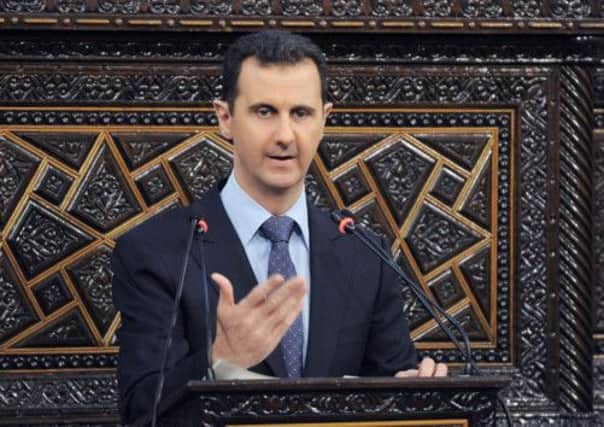Israel aim Syria airstrike at ‘Hezbollah weapons’


It was the second Israeli strike this year against Syria and the latest salvo in its long-running effort to disrupt Hezbollah’s quest to build an arsenal capable of defending against Israel’s air force and spreading destruction inside the Jewish state.
The strike comes as the US considers how to respond to indications that the Syrian regime may have used chemical weapons in its bloody civil war.
Advertisement
Hide AdAdvertisement
Hide AdPresident Barack Obama has described the use of such weapons as a “red line,” and the administration is weighing its options – including possible military action.
Israeli prime minister Benjamin Netanyahu has repeatedly warned in recent weeks that Israel would be prepared to take military action if chemical weapons or other arms that would upset the balance of power with Hezbollah were to reach the Islamic militant group.
The Israeli officials said the attack took place early on Friday and was aimed at sophisticated “game-changing” weapons, but not chemical arms. One official said the target was a shipment of advanced, long-range ground-to-ground missiles. It was not made clear where the attack took place, or whether the air force carried out the strike from Lebanese or Syrian airspace.
US officials had earlier confirmed the airstrike but said that it appeared to have hit a warehouse.
Syria’s assistant information minister, Khalaf Muftah, told Hezbollah’s Manar TV that he has “no information about an aggression that was staged,” and said reports of an Israeli air raid “come in the framework of psychological war in preparation of an aggression against Syria”.
Hezbollah declined to comment.
Israel has cast a wary eye on Syria’s civil war, which has on several occasions spilled over into Israel as well as Turkey, Lebanon and Iraq. The Jewish state is particularly worried about president Bashar al-
Assad’s stockpile of chemical weapons being transferred to Hezbollah or falling into the hands of Islamic extremists fighting in the rebel ranks.
Concerns about Syria’s chemical weapons have spiked in recent weeks amid growing indications that the Assad regime may have used them against the uprising at home.The US has said intelligence indicates the Syrian government is most likely to have used the deadly nerve agent sarin on at least two occasions, echoing earlier assessments from allies Britain, France and Israel.
Advertisement
Hide AdAdvertisement
Hide AdObama has characterised the use of chemical weapons as a “game-changer” that would have “enormous consequences,” but has also said he needs more definitive proof before making a decision about how to respond – and whether to take military action.
There appears to be little push at the moment to intervene directly, and Obama said yesterday that he didn’t foresee a scenario in which the US would send troops to Syria.
Instead, US defence secretary Chuck Hagel said on Thursday that Washington is rethinking its opposition to arming the opposition. The US so far has baulked at sending weapons to the rebels, fearing the arms could end up in the hands of al-Qaeda-linked groups or other extremists in the opposition ranks.
Meanwhile, hundreds of Sunni Muslim families fled Syria’s coastal town of Banias yesterday, fearing further sectarian violence after fighters loyal to Assad killed dozens of people overnight on Friday, according to activists.
The activists said the killings in the Ras al-Nabaa district of Banias took place two days after state forces and pro-Assad militias killed at least 50 Sunnis in the nearby village of Baida.
The Syrian Observatory for Human Rights, a pro-opposition monitoring group, posted online a video showing the bodies of ten people it said were killed in Ras al-Nabaa –half of them children.
Some were lying in pools of blood, and one toddler was covered in burns, her clothes singed and her legs charred.
Activist reports and videos on the killings could not be independently verified as the Syrian government restricts access for independent media.
Advertisement
Hide AdAdvertisement
Hide AdThe two-year-old uprising against four decades of Assad family rule has been led by Syria’s Sunni Muslim majority, and sectarian clashes and alleged massacres have become increasingly common in a conflict that has killed more than 70,000 people.
Minorities such as the Alawites, an offshoot of Shi’ite Islam, have largely stood behind Assad, who is from the Alawite sect.
Banias is a Sunni pocket in the midst of a large Alawite enclave on Syria’s Mediterranean coast, and activists in the area accuse militias loyal to Assad of ethnic cleansing.
“I estimate that hundreds of families left and headed for nearby towns like Jableh and Tartous,” said Rami Abdelrahman, head of the British-based Syrian Observatory.
“But now the army is turning people back at the checkpoints outside the town, telling them to go back to Banias, that nothing is wrong.”
Another video posted online by activists showed what they said were the bodies of 20 people killed in Banias overnight, all from the same family, including women and children.